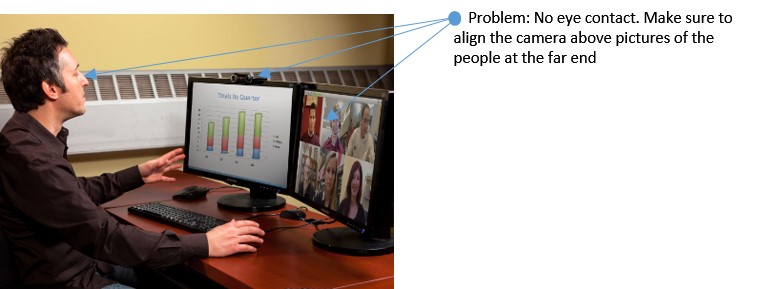If you coach an international team, you should already be adept at applying cultural concepts to produce effective 1:1 video meetings with your staff. Most new managers have to figure out the mechanics on their own. I have coached an engineering team situated across the globe, working virtually for over ten years, but it was not until my MBA coursework that I discovered the keys. I realized that the traditional cultural awareness strategies for effective in-person team and private meetings can be effective at managing global teams and projects at a distance. provided we pay attention to the technology.
Most of what I have to share are simple observations that just need to put in to practice to build lasting business relationships across the globe. The mechanics are simple. To be culturally competent, we need to recognize the impact of the remote collaboration technology. We want to transmit and perceive as much non-verbal information from our distant co-workers as possible. It only takes is a few minutes to prepare the system before you make personal video call.
Five steps to initiating successful one-to-one culture-bridging video sessions:
1. A high quality desktop videoconferencing appliance is preferable over desktop software. Cisco DX and EX series are examples of purpose-built devices for high context conversations. If your team is going to engage in lots of long distance 1:1 calls, these systems are a wise investment.
2. If you must use desktop software, before calling:
Avoid using an iPad or a laptop for a 1:1 video. If there is no alternative, prop up the device. Line camera up with your head instead of looking down at the display. Audio is more of priority than video, so be sure to use a headset instead of the iPad/Laptop’s built-in microphone.
Choose a high quality camera, like the Logitech c930e.
Position the camera directly above the computer monitor that will be showing the image of the caller.
Conferencing Advisors (2015). Vidyo Desktop. Retrieved from http://conferencingadvisors.com/product/vidyodesktop
3. Use your self-view :
- Check for good light on yourself and reduce background light and distractions.
- Adjust the tilt of the camera and your seat to square your head and shoulders in the shot.
- Avoid sitting too close to the display. Make your body language part of the conversation. For emphasis, lean towards the camera.
- Only check your self-view occasionally to confirm positive non-verbal cues, such as open arms, engaging expression.
- Make strong eye contact by positioning the “window” showing the person at the far end of the call directly below your web camera.
- Occasionally stare directly into the camera when the other party is making a key point in order to reinforce that you are paying attention.
3. To establish more effective high-context communication in a conference room:
- Choose a seat in the room that is half way to the screen, and not the front row. At a reasonable distance back from the display, eye contact will appear be better to the fare end. The shift of your eye between the camera and the display showing far end will be less noticeable the further back you sit.
- Adjust the environment: close the shades and activate the lighting.
- Use the self-view to adjust your camera to more than a head and shoulders shot.
- Include your arms and hands and save the preset.
- Many systems recall a wide shot when calls connect, so store the preset in advance.
- First impression matters most, so avoid the awkward time laps when that occurs when you have to concentrate on adjusting the camera when the call connects.
- A stored preset also helps if the call disconnects and automatically returns to the wide shot.
DNP (2015). Videoconferencing with large optical screens. Retrieved from http://www.dnp-screens.com/DNP08/Segmenter/Conference-room/Video-conference-screen.aspx
- If someone is in the room with you, have them sit on the same side of the table so that the image you are transmitting is mostly of people and does not have to widen out and show a lot of table.
- This seating arrangement reinforces a partnership, whereas across the table introduces more physical barriers and sends more non-essential information to the distant associate.
- In many cases, a wider shot also introduces background distractions and windows that will impede the camera’s ability to capture the correct light level for your face.
- Ask the other side to adjust their camera and sit in a similar fashion.
- Request this camera adjustment as early into the call as possible, because once the session starts, it will be awkward to request camera changes, particularly if it requires moving chairs, zooming in or figuring out the camera controls on a remote or touch panel.
4. The goal is to appear to be looking into the other person’s eyes when you look at their face on the screen.
- Use a smaller conference room for a personal video calls, because large displays increases the distance between the camera and the center-line of the display.
- Use single display systems for 1:1 sessions. With dual display systems, the camera is not in line with the display so you cannot appear to be making proper eye contact.
5. Once the conversation starts, concentrate on the other end of the call. Avoid distractions and use your self-view only occasionally to check your expression and body language to make sure you are sending culturally appropriate non-verbal cues.
Opposite Point of View
Is all this focus on cultural competency necessary? After all, if we are co-workers, then we are expected to work across the globe in the same fashion, following the same company culture of respecting each other’s differences. Plus, we are using the same technology and most likely we are speaking in the same language (typically English, as mandated by the company). So why not get on with the work at hand and forget this cultural “air play”?
Many global managers are already holding 1:1 sessions with their leads situated in remote locations. These sessions can be more productive once we recognize that we bring to every personal encounter our social values that transcend the corporate culture. The ways people think and communicate are subtly different, even if they are speaking the same language. There will be no bang over the head when you stumble into cultural disagreement. When points of view are not clearly understood, the impact is more subtle. Initiatives start to slow down. Cultural differences are nuances that we need to interpret by being highly observant. The goal is to gain every possible advantage so that we can avoid creating barriers to agreement and our company can innovate and implement as quickly as possible.
TURNING POINT is Mark Peterson's personal take on innovation and collaboration influencing today's corporate strategy. To have a conversion about what takes to implement collaborative solutions efficiently and at enterprise scale, contact Mark Peterson



